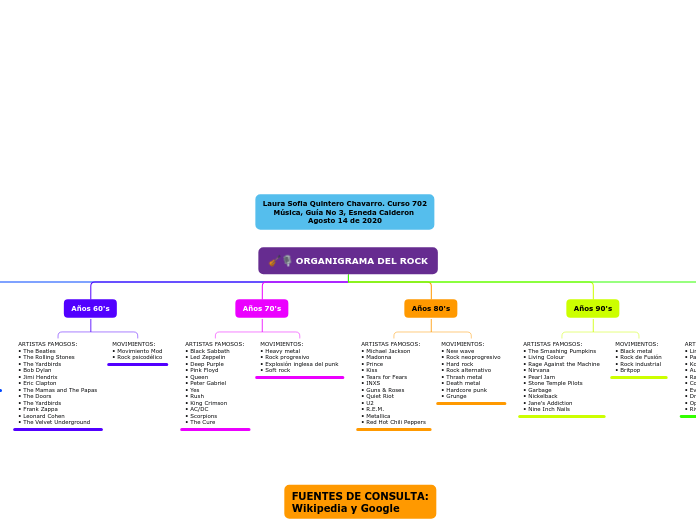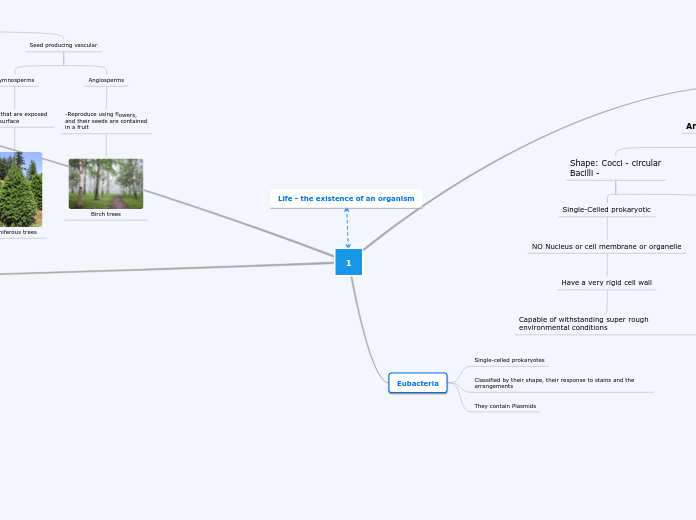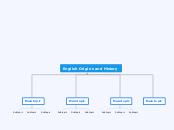Floating topic
methabolic pathways
The prossess of makinf and breaking down carbohydrates molecules illustrated two types of metabolic pathways. A metabolic pathway is a step-by-step series of interconnected biochemical reactions that convert a substrate molecule or molecules through a series of metabolic intermediates, eventually yielding a final product or products. For example, one metabolic pathway for carbohydrates breaks large molecules down into glucose. Another metabolic pathway might build glucose and referred to a molecules for storage.
Catabolism
Catabolic pathways are those that generate energy by breaking down larger molecules.
Anabilism
-are those that require energy to synthesize larger molecules.
Both types of pathways are required for maintaining the cell's energy balance.
Evolution is defined as a change in the inherited characteristics of biological populations over successive generations.
Microevolution
Macroevolution refers to major evolutionary changes over time, the origin of new types of organisms from previously existing, but different, ancestral types. Examples of this would be fish descending from an invertebrate animal, or whales descending from a land mammal. The evolutionary concept demands these bizarre changes.
Microevolution is simple a change in gene frequency within a population.
Evolution can be observed over short periods of time such as from one generation to the next
Charles Darwin (1809-1882) is credit with proposing that the mechanism for the process of evolution is natural selection.
He established that all species of life have descended over time from common ancestors, and proposed the scientific theory that this branching pattern of evolution resulted from process that he called natural selection.
AP Biology Concept Map
Ecology
Community
In ecology, a community or biocoenosis is an assemblage or association of populations of two or more different species occupying the same geographical area and in a particular time. The term community has a variety of uses.
Deals with the whole array of interacting species in a community.
Behaviors
Learned
Habituation
Insight learning
Insight learning is applying something already learned to a new situation without a period of trial and error
Conditioning
Operant
Is a behavior learned through repeated practice to receive a reward or to avoid a punishment.
classical
this is achieved by repeated pairings of the neutral stimulus with the potent stimulus
Imprinting
a young animal come to recognize another animal, person, or thing as a parent or other object of habitual trust.
Innate
stimulus
Something that happens to trigger a certain behavor
instinct
is the ability of an animal to perform a behavior the first time it is exposed to the proper stimulus.
Behavioral ecology is how same and different species interact with each other.
Ecosystem
Biomes
a large naturally occurring community of flora and fauna occupying a major habitat, e.g., forest or tundra.
A biomass pyramids are made up one different levels . One type of pyramid contains Primary producers, Primary consumers, Secondary consumers, Tertiary consumers.
Another pyramid is much simple and only contains Primary producer, and Primary consumer.
An ecosystem is the community of organism in an area and physical factors with which they interact
Biotic
Biotic components are the living things that shape an ecosystem. Biotic components usually include: Producers, autotrophs: e.g. plants, they convert the energy from photosynthesis , or other sources such as hydrothermal vents into food.
Both biotic and abiotic factors are related to each other in an ecosystem, and if one factor is changed or removed, it can affect the entire ecosystem. Abiotic factors are especially important because they directly affect how organisms survive.
Abiotic
Abiotic factors are all of the non-living things in an ecosystem.
Microclimate
A microclimate is a local set of atmospheric conditions that differ from those in the surrounding areas, often with a slight difference but sometimes with a substantial one
Population
The population is a group of individual of the same species living in an area.
There are many different ways to estimate the population size .
Mark and recapture technique. Formula population size .
Adaptive Radiation
Adaptive radiation is the evolution of diversity within a rapidly multiplying lineage. It can cause a single ancestral species to differentiate into an impressively vast array of species inhabiting a variety of environments
Adaptive radiation is a rare case and is cause by long distance dispersal
Uniform Distribution
Uniform dispersion is observed in plant species that inhibit the growth of nearby individuals.
Results from intense competition or antagonism between individuals
Random dispersion occurs with dandelion and other plants that have wind-dispersed seeds that germinate wherever they happen to fall in a favorable environment.
Occurs when there is no competition antagonism, or tendency to aggregate.
Clumping
Clumped dispersion is seen in plants that drop their seeds straight to the ground, such as oak trees, or animals that live in groups, such as schools of fish or herds of elephants. Clumped dispersions may also result from habitat heterogeneity. If favorable conditions are localized, organisms will tend to clump around those, such as lions around a watering hole.
Is the most common distribution because environmental conditions are seldom uniform.
Evolution
Macroevolution
Macroevolutionary studies focus on change that occurs at or above the level of species, in contrast with microevolution, which refers to smaller evolutionary change within a species or population
Speciation
A species is of interbreeding organisms that produce viable, fertile offspring in nature.
Sympatric speciation- speciation occurs even though the two groups are still living in the same area.
Sympatric speciation occurs when populations of a species that share the same habitat become reproductively isolated from each other. This speciation phenomenon most commonly occurs through polyploidy, in which an offspring or group of offspring will be produced with twice the normal number of chromosomes.
Speciation can occur by polyploidy. My understanding of the process is as follows: 'polyploidy is when the number of chromosomes in an organism's cell doubles. This means that the organism has more chromosomes than other individuals of the same species, meaning it cannot mate with other individuals.Mar 10, 2013
Sympatric speciation is the process through which new species evolve from a single ancestral species while inhabiting the same geographic region. ... Parapatric speciation is the evolution of geographically adjacent populations into distinct species.
Scientists think that geographic isolation is a common way for the process of speciation to begin: rivers change course, mountains rise, continents drift, organisms migrate, and what was once a continuous population is divided into two or more smaller populations.
Allopatric speciation- When a given group has been separated from the parent group, usually because of geography separation as time goes by.
The biological equivalent is "allopatric speciation," an evolutionary process in which one species divides into two because the original homogenous population has become separated and both groups diverge from each other.
Allopatric speciation is just a fancy name for speciation by geographic isolation, discussed earlier. In this mode of speciation, something extrinsic to the organisms prevents two or more groups from mating with each other regularly, eventually causing that lineage to speciate.
Sympatric speciation. A controversial alternative to allopatric speciation is sympatric speciation, in which reproductive isolation occurs within a single population without geographic isolation. In general, when populations are physically separated, some reproductive isolation arises
Phylogentic tree
The study of the evolutionary relationships among a group of organisms
Based on morphology and the fossil record, embryology, DNA, RNA, and protein similarities
Tree like structure
Taxonomy
Hierarchal scheme, the largest most inclusive grouping in the kingdom.
Taxonomy is the classification of organisms based on shared characteristics.
Based on structural (outward and inward) similarities
The most specific group is the species level
Cellular Processes
Cell communication
Autocrine Signaling
Autocrine signalling is a form of cell signalling in which a cell secretes a hormone or chemical messenger (called the autocrine agent) that binds to autocrine receptors on that same cell, leading to changes in the cell.
Endocrine Signaling
These Endocrine secretions are distinguished from exocrine secretions, which are released to the external environment. Thus, endocrine signaling occurs when endocrine cells release hormones that act on distant target cells in the body.
The major endocrine glands include the pineal gland, pituitary gland, pancreas, ovaries, testes, thyroid gland, parathyroid gland, and adrenal glands. The endocrine system is in contrast to the exocrine system, which secretes its hormones to the outside of the body using ducts.
The endocrine system is the collection of glands that produce hormones that regulate metabolism, growth and development, tissue function, sexual function, reproduction, sleep, and mood, among other things.
According to TeensHealth, the endocrine system is important because it regulates tissue function, mood, metabolism, growth and development, sexual function and reproductive processes. It influences nearly all cells, organs and functions of the human body.
Paracrine Signaling
Paracrine signaling is a form of cell-to-cell communication in which a cell produces a signal to induce changes in nearby cells, altering the behavior of those cells.
Autocrine signals are produced by signaling cells that can also bind to the ligand that is released, which means the signaling cell and the target cell can be the same or a similar cell. Direct signaling can occur by transferring signaling molecules across gap junctions between neighboring cells.
Chemical signals secreted by cells can act over varying distances. In the autocrine signaling process, molecules act on the same cells that produce them. In paracrine signaling, they act on nearby cells. Autocrine signals include extracellular matrix molecules and various factors that stimulate cell growth.
Cellular communication is an umbrella term used in biology and more in depth in biophysics and biochemistry to identify different types of communication methods between living cells. Some of the methods include cell signaling among others.
Cell communication is the process by which a cell detects and responds to signals in its environment. Most single-celled organisms can perceive changes in nutrient availability and adapt their metabolism as needed.
Cellular respiration
Cellular respiration is a set of metabolic reactions and processes that take place in the cells of organisms to convert biochemical energy from nutrients into adenosine triphosphate (ATP), and then release waste products.
Involves glucose molecules combined with oxygen
Which then releases energy tied up in molecular bonds
and CO2, a waste product, will be "breathed out"
The energy released is trapped in the form of ATP for use by all the energy-consuming activities of the cell.
The process occurs in two phases:
glycolysis, the breakdown of glucose to pyruvic acid
the complete oxidation of pyruvic acid to carbon dioxide and water
C6H1206 (glucose) + 6O2 = 6CO2 + 6H2O+ energy
O2 is taken from the air and CO2 is released as waste
Performed by animals and plants does not require light
Photosynthesis
Complementary processes
Allows matter and energy to transform between living things and environment
All organisms are interconnected by their need for food
And Chemical input of energy from the sun keeps this process going
Total amt. of energy and matter in the environment remains constant
A chemical reaction
This chemical reaction that contains chlorophyll pigments in plant cells absorbing photons from the sun
which is then converted to chemical energy for plant growth/reproduction
And Plants can then be eaten by other organisms in high trophic levels in the food web and that energy is eventually recycled via decomposers who put elements back into the soil
Element involved will cycle in different forms through the food web.
Is performed by plants and requires light (sun)
Biochemistry
What causes water molecules to both cohere and adhere
Surface tension is a measure of how hard it is to break the surface of a liquid. Surface tension is a consequence of cohesion. What causes it? HYDROGEN BONDING!
Temperature: water has a high heat capacity. Heat capacity is the amount of heat required to raise 1 gram of water by 1 degree Celsius (1 calorie= 4.184 J) . What does that mean? It means water can absorb large quantities of heat without much change in its own temperature, thus it's a good thermo regulator. But why? HYDROGEN BONDING
Cohesion is when water molecules stick to each other and adhesion is when water molecules stick to some other types of substances like plant cell walls
Water: the molecules that support life on this planet
Most cells are surrounded by water, and cells themselves are about 70-95% water
The abundance of water is the main reason the Earth is habitable
- Water is the biological medium for life on Earth
All living organisms require water more than any other substance
Biochemistry is the branch of science that explores the chemical processes within and related to living organisms. It is a laboratory based science that brings together biology and chemistry. By using chemical knowledge and techniques, biochemists can understand and solve biological problems.
Genetics
Biotech
the exploitation of biological processes for industrial and other purposes, especially the genetic manipulation of microorganisms for the production of antibiotics, hormones, etc.
Modern biotechnology provides breakthrough products and technologies to combat debilitating and rare diseases, reduce our environmental footprint, feed the hungry, use less and cleaner energy, and have safer, cleaner and more efficient industrial manufacturing processes.
Reducing rates of infectious disease;
Saving millions of children's lives;
Changing the odds of serious, life-threatening conditions affecting millions around the world;
Tailoring treatments to individuals to minimize health risks and side effects;
Creating more precise tools for disease detection; and
Combating serious illnesses and everyday threats confronting the developing world.
Gene to protien
Translation, the second step in getting from a gene to a protein, takes place in the cytoplasm. The mRNA interacts with a specialized complex called a ribosome, which "reads" the sequence of mRNA bases. Each sequence of three bases, called a codon, usually codes for one particular amino acid.May 16, 2017
The process by which the information in DNA is used to produce RNA. The RNA produced from transcription can then be decoded to create a sequence of amino acids. And now…Translation: The process of using an RNA template to create a polypeptide or protein made of amino acids.
From this strand the protein will be synthesized, this is called translation (RNA is translated into protein). A protein is made from amino acids, these form a strand. ... The translation of RNA to protein is different than the synthesis of RNA from DNA (transcription).
The amino acid sequence of the polypeptide chain. Which of the following is an example of secondary structure in a protein? ... How are genes used by cells to build proteins? The genes in DNA direct the synthesis of an RNA molecule, which is used to build a protein.
Each gene tells the cell how to put together the building blocks for one specific protein. However, the gene (DNA) sits inside a different compartment of the cell (the nucleus) from the location of the cellular machines that make proteins (ribosomes).
Chromosomal & molecular basis
Independent assortment
--random distribution of homologous chromosomes during meiosis
--one of Mendel's principles that states that genes for different traits can segregate independently during the formation of gametes
--Punnett square demonstrates the possibilities
--random alignment of tetrads in synopsis can produce gametes containing all possible combinations of parental alleles at loci located on different chromosomes
Random Distribution
A statistical distribution in which the variates occur with probabilities asymptotically matching their "true" underlying statistical distribution is said to be random.
A group of organisms of one species that interbreed and live in the same place at the same time. Clumped distribution is the most common type of dispersion found in nature. In clumped distribution, the distance between neighboring individuals is minimized.
Random alignment
At this stage, the four chromatids are visible in each homologous pairing and are called a tetrad. Explain how the random alignment of homologous chromosomes during metaphase I contributes to the variation in gametes produced by meiosis. Random alignment leads to new combinations of traits.
The random alignment of chromosomes during metaphase I allows equal opportunity for a particular chromosome to migrate into a cell. This type of independent assortment gives rise to exponential gene combinations in the offspring.
This is necessary for the independent assortment of genes, an important principle of genetics. It also allows for gametes, and thus offspring, to be much more genetically variable than they would be if all the paternal and maternal chromosomes were inherited as a unit.
Punnet squares
The Punnett square is a diagram that is used to predict an outcome of a particular cross or breeding experiment. It is named after Reginald C. Punnett, who devised the approach. The diagram is used by biologists to determine the probability of an offspring having a particular genotype.
On a Punnett square, columns are assigned to the mother and the rows to the father, or vice versa. Write a letter next to each row and column that represents each of the mother's and father's alleles. Use capital letters for dominant alleles and lowercase for recessive alleles.
pedigree analysis. The study of an inherited trait in a group of related individuals to determine the pattern and characteristics of the trait, including its mode of inheritance, age of onset, and phenotypic variability.
Mendel
second law
A dihybrid cross is a cross between individuals heterozygous at two different loci. Mendel's second law is also known as the law of independent assortment. The law of independent assortment states that the alleles of one gene sort into gametes independently of the alleles of another gene.
The recessive trait will only result if both factors are recessive. Mendel's observations and conclusions are summarized in the following two principles, or laws. The Law of Segregation states that for any trait, each parent's pairing of genes (alleles) split and one gene passes from each parent to an offspring.
Mendelian inheritance is a type of biological inheritance that follows the laws originally proposed by Gregor Mendel in 1865 and 1866 and re-discovered in 1900. These laws were initially very controversial.
Pea plants have both male and female reproductive organs. As a result, they can either self-pollinate themselves or cross-pollinate with another plant. In his experiments, Mendel was able to selectively cross-pollinate purebred plants with particular traits and observe the outcome over many generations.
first law
To summarize, Mendel's first law is also known as the law of segregation. The law of segregation states that, ' the alleles of a given locus segregate into separate gametes.' Alleles sort independently because the gene is located on a specific chromosome.
◇ Mendel's third law (also called the law of dominance) states that one of the factors for a pair of inherited traits will be dominant and the other recessive, unless both factors are recessive. See more at inheritance.
Mendel's second law is also known as the law of independent assortment. The law of independent assortment states that the alleles of one gene sort into gametes independently of the alleles of another gene.
Mitosis/meiosis
Mitosis
a type of cell division that results in two daughter cells each having the same number and kind of chromosomes as the parent nucleus, typical of ordinary tissue growth.
Stages of Mitosis Mitosis. A four-stage process that creates two identical cells from one original cell.
Stages of Mitosis Mitosis. A four-stage process that creates two identical cells from one original cell.
Prophase. The first and longest stage of mitosis. ...
Metaphase. The second stage of mitosis. ...
Anaphase. The third stage of mitosis. ...
Telophase. The fourth and last stage of mitosis. ...
Cytokinesis. ...
Interphase. Mitosis. A four-stage process that creates two identical cells from one original cell.
Prophase. The first and longest stage of mitosis. ...
Metaphase. The second stage of mitosis. ...
Anaphase. The third stage of mitosis. ...
Telophase. The fourth and last stage of mitosis. ...
Cytokinesis. ...
Interphase.
Cytokinesis
the cytoplasmic division of a cell at the end of mitosis or meiosis, bringing about the separation into two daughter cells.
Anaphase
the stage of meiotic or mitotic cell division in which the chromosomes move away from one another to opposite poles of the spindle.
Metaphase
the second stage of cell division, between prophase and anaphase, during which the chromosomes become attached to the spindle fibers.
Prophase
the first stage of cell division, before metaphase, during which the chromosomes become visible as paired chromatids and the nuclear envelope disappears. The first prophase of meiosis includes the reduction division.
Meiosis
Meiosis is a type of cell division that reduces the number of chromosomes in the parent cell by half and produces four gamete cells. This process is required to produce egg and sperm cells for sexual reproduction.
Since cell division occurs twice during meiosis, one starting cell can produce four gametes (eggs or sperm). In each round of division, cells go through four stages: prophase, metaphase, anaphase, and telophase.
Subtopic









